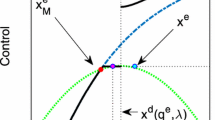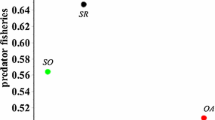Abstract
This paper examines the problem of the optimal management of a joint-ownership fishing exploitation, where agents use different fishing gears. We consider a model in which the fishing activity may affect resource growth, not only through the harvest function but also through the natural growth rate of the resource. This allows us to capture the fact that some fishing gears alter the natural growth rate of the resource. We find that when the natural growth of the resource is altered by the fishing technology, the optimal stock is not independent of how harvest quotas are distribute among the agents. As a result, a fishing policy that firstly determines the optimum stock and, secondly, decides how to distribute the harvest among the different agents, will not be efficient. We also analyze the joint determination of optimal stock and harvest quotas and show that positive harvest quotas will only be optimal when countries are characterized by certain asymmetries.
Similar content being viewed by others
References
Anon (1983), Council Regulation (EEC) 170/83.
Anon (1992), Council Regulation (EEC) 3760/92.
Armstrong, C.W. (1999), ‘Sharing a Fish Resource-Bioeconomic Analysis of an Applied Allocation Rule’, Environmental and Resource Economics 13, 75–94.
Armstrong, C. W. and D. J. Clark (1997), ‘Just Fishing? Equity and Efficiency in Fisheries Management Regimes’, Marine Resource Economics 12, 203–220.
Armstrong, C. and U. R. Sumaila (2001), ‘Optimal Allocation of TAC and the Implications of Implementing an ITQ Management System for the North-East Arctic Cod’, Land Economics 77(3), 350–359.
Boyce, J. R. (1996), ‘An Economic Analysis of the Fisheries Bycatch Problem’, Journal of Environmental Economics and Management 31, 314–336.
Clark, C. W. (1990), ‘Mathematical Bioeconomics. The Optimal Management of Renewable Resources’, 2nd ed. New York: John Wiley & Sons.
Garza Gil, M. D. (1998), ‘ITQ Systems in Multifleet Fisheries. An Application for Iberoatlantic Hake’, Environmental and Resource Economics 15, 93–106.
Lleonart, J., L. Silvani, I. Fernandez-Cuevas, A. Gual (1996), ‘La Crisis Pesquera Española: Un Enfoque Ecológico’, La Situación del Mundo. Lester R. Brown (appendix).
Mesterton-Gibbon, M. (1993), ‘Game Theoretic Resource Modeling’, Natural Resource Modeling 7, 93–147.
Munro, G. R. (1979), ‘The Optimal Management of Transboundary Renewable Resources’, Canadian Journal of Economics 12, 355–376.
Munro, G. R. and A. D. Scott. (1985), ‘The Economics of Fisheries Management’, Handbook of Natural Resource and Energy Economics II, A. V. Kneese and J. L. Sweeney. Elsevier Science Publisher B. V
Turner, M. A. (1997), ‘Quota Induced Discarding in Heterogeneous Fisheries’, Journal of Environmental Economics and Management 33, 186–195.
Ward, J. M. (1994), ‘The Bioeconomic Implications of a Bycatch Reduction Device a Stock Conservation Management Measure’, Marine Resource Economics 9, 227–240.
Author information
Authors and Affiliations
Rights and permissions
About this article
Cite this article
Escapa, M., Prellezo, R. Fishing Technology and Optimal Distribution of Harvest Rates. Environmental and Resource Economics 25, 377–394 (2003). https://doi.org/10.1023/A:1024478107203
Issue Date:
DOI: https://doi.org/10.1023/A:1024478107203




